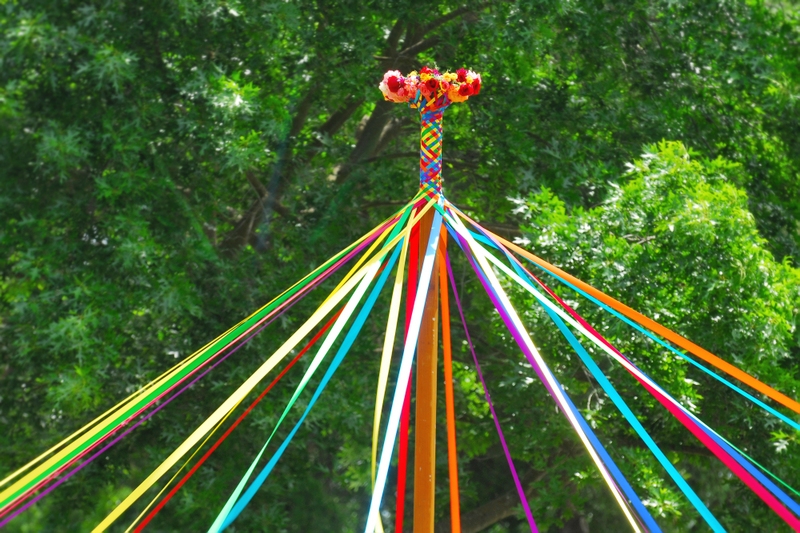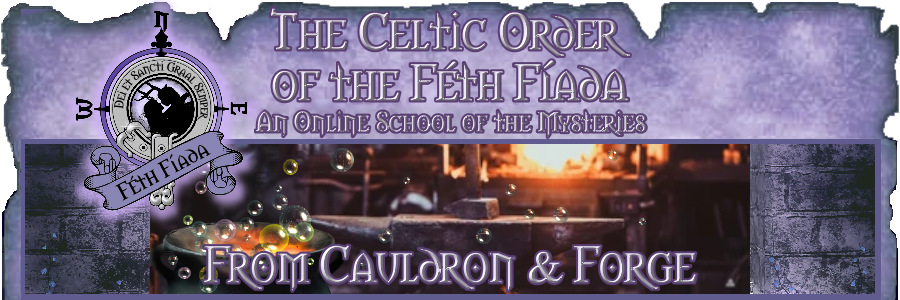
For those who don’t know, here at COFF, we follow astrological timing for our Wheel of the Year. That means that for us, Beltaine falls on May 5, at 15 degrees Taurus. Beltaine (pronounced “bee-all-tin-uh” < Proto-Celtic *Belo-Te(p)niâ Bright Fire) is the first day of summer. In Wales, it is known as Calan Haf (Calends of Summer). Traditionally in ancient times, it was a pastoral celebration, when the cattle, sheep, and other livestock were herded up for the summer to the “high pastures,” located in the hills. Prior to that, however, on Beltaine Eve, the animals were driven over or between the flames of one or two Beltaine fires, respectively, in order to bless, purify, and protect them, ensuring fertility. These were “need-fires” (ignited in the primitive fashion of rubbing two sticks together or by “drilling” a stick into a small log, i.e., by wimble and plank),[1] from which the community would then rekindle their own hearth fires, which were all extinguished at this time.
For the ancient Celts, the purposes of the need-fire (Irish tein-éigen, Welsh tân-angen) were purging, purification, and protection. The need-fire was a magickal fire. Hence, all other fires for some distance around must be extinguished prior to its lighting, so as not to prevent the need-fire from drawing the power it required to work its magick. If the need-fire would not light, then a search of the surrounding area ensued, in order to find any fires as yet burning, and those householders guilty of failing to douse their fires were severely punished and/or heavily fined. Also known as the “wild-fire,” “living-fire,” or “force-fire,” the need-fire purged disease among horses, cattle, sheep, goats, and pigs, and sometimes geese, as well. It purified the households into which its brands and coals were carried to ignite the hearth fires anew, and its ashes were strewn in the fields to protect the crops and herds alike. The need-fire was principally associated with Beltaine, Midsummer, and Samain (Calan Gaeaf), but might be built and lit at any time if cattle plagues or other illnesses broke out and spread among the livestock.
The need-fire served as a bridge between the worlds on holy days because, ultimately, to the ancients, it represented the sacred force that spun the Cosmic Mill and kept all the worlds turning. Hence, in later years, instead of from the friction created by two pieces of dry wood, the need-fire was often ignited by means of a mechanism reliant on a cart- or spinning-wheel, known as the “muckle wheel.” In some regions, a hammer and an anvil were employed instead to strike the spark that lit the need-fire, and this was associated with the Divine Spark of life gifted to all living beings and creatures. When death occurs, this inner spark or fire is extinguished and must be renewed for rebirth to occur — one of the things that made the Smith Gods and their fiery forges so vital.
The month of May, during which Beltaine occurs, has often been referred to as the “lusty month.” Summer and the Light Half of the Year had arrived, and after the long winter and the Dark Half of the Year, the ancient Celts were more than ready to get out of their homes and into the fresh air and, especially, the sunlight again. After all, the brightest fire of all is the Sun, with which the God Belenos (Bright, Shining; Strong) was associated; he was often the principal God celebrated at Beltaine, along with his consort, Belisama (Most Bright; Most Strong), who was connected to a number of rivers.
There are several references to Bealtaine being dedicated to such a deity [Belenos] in Medieval Irish texts — as early as the Leabhar na hUidre (Book of the Dun Cow, early 12th c.). A passage in Tochmarc Emire (The Wooing of Emer) lists all four festivals in a convoluted series of kennings, and associates Bealtaine with an “idol” called Bel toward the end of the passage.
‘Bend Suain, son of Rosc Mele, which she said this is the same thing, viz., that I shall fight without harm to myself from Samuin, i.e., the end of summer. For two divisions were formerly on the year, viz., summer from Beltaine (the first of May), and winter from Samuin to Beltaine. Or sainfuin, viz., suain (sounds), for it is then that gentle voices sound, viz., sám-son ‘gentle sound’. To Oimolc, i.e., the beginning of spring, viz., different (ime) is its wet (folc), viz the wet of spring, and the wet of winter. Or, oi-melc, viz., oi, in the language of poetry, is a name for sheep, whence oibá (sheep’s death) is named, ut dicitur coinbá (dog’s death), echbá (horse’s death), duineba (men’s death), as bath is a name for ‘death’. Oi-melc, then, is the time in which the sheep come out and are milked, whence oisc (a ewe), i.e., oisc viz., barren sheep. To Beldine, i.e. Beltine, viz., a favouring fire. For the druids used to make two fires with great incantations, and to drive the cattle between them against the plagues, every year. Or to Beldin, viz., Bel the name of an idol. At that time the young of every neat were placed in the possession of Bel. Beldine, then Beltine. To Brón Trogaill, i.e. Lammas-day, viz., the beginning of autumn; for it is then the earth is afflicted, viz., the earth under fruit. Trogam is a name for ‘earth.’’[2]
For various reasons, it is remotely possible that Belenos and Belisama are related to the Irish God Bile and Goddess Danu.[3]
Another pair of deities usually associated with Beltaine are the Green Man and the Green Woman. Later developments include the King of the May or Garland or May King and the Queen of the May or May Queen; the Oak King; the Jack in the Green; Green George (St. George); and the Morris Green Man boasted by some troupes of Morris Dancers. The Green Man has been likened to the Woodwose or Wild Man of the Woods, and the Green Woman to the Wild Woman of the Woods, as well. Traditionally, the May Queen was often chosen at the end of the Maypole Dance, being the last woman holding a ribbon and/or standing after a series of physical challenges, culminating in the dance, to test her worthiness for the role.
The May King was her consort, and together, the two of them symbolized the Hieros Gamos (Holy or Sacred Marriage or Union) between the God and the Goddess at this time, widely celebrated by Wiccans. The Maypole itself is not a particularly ancient tradition, apparently dating only from the medieval period. In Great Britain, “the earliest recorded evidence comes from a Welsh poem written by Gryffydd ap Adda ap Dafydd in the mid-14th century, in which he described how people used a tall birch pole at Llanidloes, central Wales.”[4]
It is frequently said to be a phallic symbol and/or representative of the World Tree. However, I myself have often wondered if the Maypole isn’t somehow connected with the far earlier Jupiter-Giant and Jupiter Columns, dating from the second and third centuries CE. The one depicted here — a color reconstruction located in Schwarzenacker, a district of Homburg, Saarland, Germany — is typical of the type, showing a mounted Jupiter, who is sometimes also portrayed with his Sun or Thunder Wheel and his Lightning or Thunderbolt, trampling his enemy, the chthonic Serpent.

The God Belenos, celebrated at Beltaine, is also associated with a horse and a Sun Wheel, and thus may be equated with Jupiter (both are Sky-Father Gods). Such columns are found widely “across Gaul and the Germanies, with an especial concentration in Gallia Belgica.”[5] Gallia Belgica was “a province of the Roman Empire located in the north-eastern part of Roman Gaul, in what is today primarily northern France, Belgium, and Luxembourg, along with parts of the Netherlands and Germany.”[6]
A far older tradition at Beltaine than the Maypole was the May Bush:
The May Bush and May Bough [were] popular in parts of Ireland until the late 19th century. This was a small tree or branch — typically hawthorn, rowan, holly or sycamore — decorated with bright flowers, ribbons, painted shells, and so forth. The tree would either be decorated where it stood, or branches would be decorated and placed inside or outside the house. It [might] also be decorated with candles or rushlights. Sometimes, a May Bush would be paraded through the town. In parts of southern Ireland, gold and silver hurling balls known as May Balls would be hung on these May Bushes and handed out to children or given to the winners of a hurling match. In Dublin and Belfast, May Bushes were brought into town from the countryside and decorated by the whole neighbourhood. Each neighbour-hood vied for the most handsome tree and, sometimes, residents of one would try to steal the May Bush of another. This led to the May Bush being outlawed in Victorian times. In some places, it was customary to dance around the May Bush, and at the end of the festivities it [might] be burnt in the bonfire.[7]
In addition, it was traditional at Beltaine to go “a’Maying,” with couples spending the night frolicking and making love until daybreak in the woods and meadows. Not legally binding unions, these were known as “Greenwood Marriages.” They celebrated the union of the God and the Goddess at this time (usually resulting in a rash of “Beltaine Babies” nine months afterward). May flowers (normally yellow) for baskets and, centuries later, Victorian tussie-mussies, as well as for garlands, wreaths, and crowns for the May King and May Queen were also gathered, and used to decorate doors, windows, byres, and even livestock, for protection. Holy wells were visited and ornately bedecked with flowers, too. For women, washing one’s face with Beltaine morning dew was thought to bestow beauty and maintain youthfulness, while for men, washing one’s hands with it brought skill with knots and nets:
…may-flowers were scattered around the house to keep away the fairies. Another old belief was that if a person washed his face in the May Eve dew he would not get sunburned during the Summer or he would not get wrinkles. Persons leaving presents of fresh milk and honey for the fairies would have a plentiful supply of butter and milk through-out the whole year. If a person was hit on the head with a bow-tree stick on May Eve he would not grow any more. Long ago the cow’s udder was washed with May-flower (?) on May Eve so that she would give plenty milk during the year.
A person going through briars three times on May-Eve and saying “all the butter come to me” would have the power to steal butter. If a person went out on May morning and skimmed the water off the well he would be boss of the village for that year. Another old custom was to tie cowslips to the cow’s udder in order that the butter would not be stolen.
There is a rhyme about the month of May as follows:- “A wet and windy May Chills the haggard with corn and hay.”
On May Eve people gathered different varieties of flowers and herbs which they mashed up. This mashed substance was called “Bealtanach.” It was rubbed on the cow’s udder and tits on May day. It was then believed that the cow would give a much better supply of milk and butter.[8]
Beltaine was considered a sidheógai (of the Faeries) evening in the country, one of the Trí Oícheanta Spiorad (Three Spirit Nights; Welsh Tri Ysbrydnos), when the Fae were believed to be abroad. Thus, it was customary to place green branches for protection over all one’s house and stable doorways, and to leave offerings of fresh milk and honey on one’s doorstep for the Faeries, so they would ensure that one had a plentiful supply of milk and butter throughout the coming year. Because fire and salt were at one time the two most sacred substances, it was considered unfortunate to give either away on May Day. To do so was to give away all your good luck, too!
Blessings!
APs Rhianwen Bendigaid
Footnotes:
[1] George, Arthur, “May Day: Beltane Fires and the May-Queen Goddess.” Academia. Web.
[2] Hughes, Kris, “A Quick Post About Belenos.” Patreon. Web.
[3] Kondratiev, Alexei, “Danu and Bile: The Primordial Parents?” Imbas, 1998. Web Archive.
[4] “Maypole.” Wikipedia. Web.
[5] Vidicus, “IOVI OPTIMO MAXIMO: to JUPITER, BEST and GREATEST.” Deo Mercurio. Web.
[6] “Gallia Belgica.” Wikipedia. Web.
[7] “Beltane.” Wikipedia. Web.
[8] “The Schools Collection.” https://www.duchas.ie/en/cbes/4427930/4358799. Web.
Sources:
“Belenus,” “Belisama,” “Beltane,” “Calan Mai,” “Exaltation (astrology),” “Gallia Belgica,” “Jupiter Column,” and “Maypole.” Wikipedia. Web.
“Beltane Lore.” Witches of the Craft. Web.
“Beltane: Not a ‘Fire Festival’…” The Atlantic Religion: A ‘Prisca Theologia’ of European Paganism. Web.
Brockway, Rev. Laurie Sue, Contributor, “Greenwood Marriages and the Fiery Passions of Beltane.” Huffpost. Web.
Cunningham, Scott & Harrington, David, The Magical Household: Spells & Rituals for the Home. Llewellyn Publications, 2002; ISBN: 9780875421247.
George, Arthur, “May Day: Beltane Fires and the May-Queen Goddess.” Academia. Web.
Grimassi, Raven, Beltane: Springtime Rituals, Lore, & Celebration. Llewellyn Publications, 2001; ISBN: 978-1567182835.
Hughes, Kris, “A Quick Post About Belenos.” Patreon. Web.
Kondratiev, Alexei, “Danu and Bile: The Primordial Parents?” Imbas, 1998. Web Archive.
Marquis, Melanie, Beltane: Rituals, Recipes & Lore for May Day. Llewellyn Publications, 2015; ISBN: 9780738741932.
O’Brien, Lora, “Beltane — Bealtaine Traditions in Irish Folklore.” The Irish Pagan School. Web.
“The Schools Collection.” Dúchas. Web.
Sermon, Richard, “The Wicker Man, May Day, and the Reinvention of Beltane.” Academia. Web.
Vidicus, “IOVI OPTIMO MAXIMO: to JUPITER, BEST and GREATEST.” Deo Mercurio. Web.










